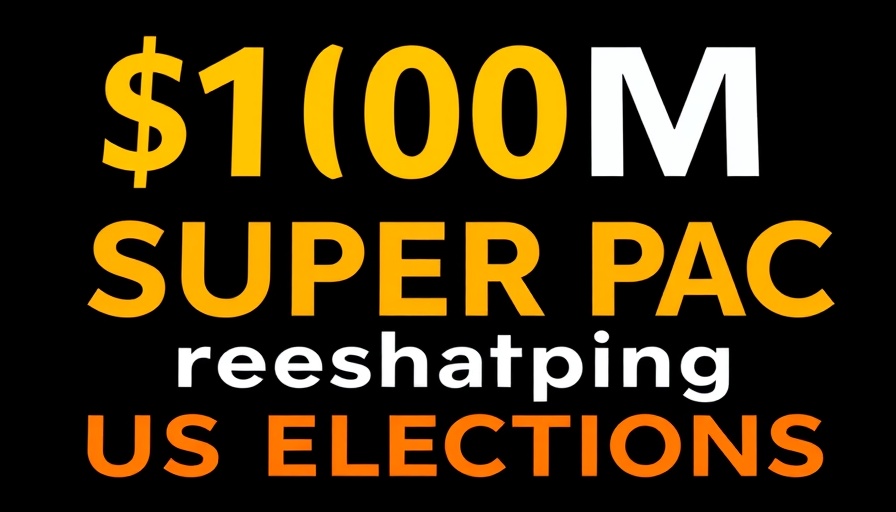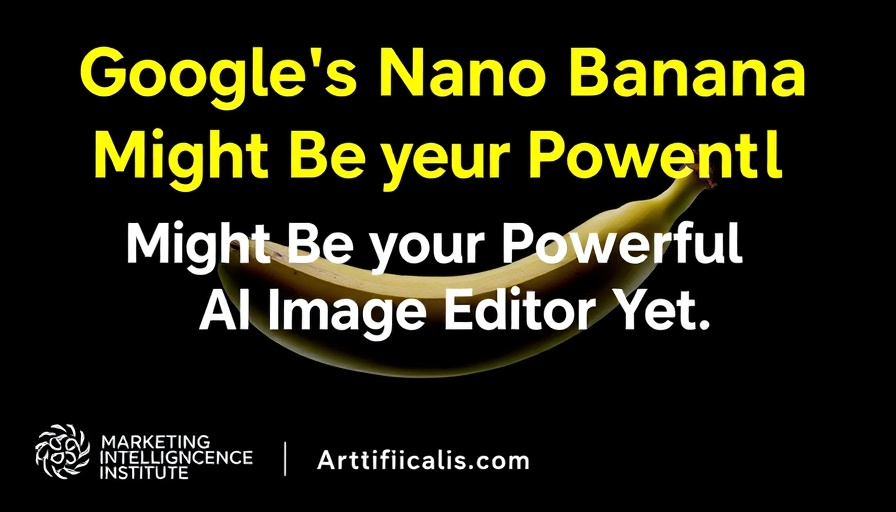
Finnish Startup Invests €29M Towards Carbon-Negative Acoustic Panels for Sustainable Building


How a $100M AI Super PAC Is Set to Transform US Elections
Update AI Super PAC: A Game Changer for US PoliticsIn a groundbreaking move that could reshape the political landscape, the introduction of "Leading the Future," a super PAC backed by $100 million, signifies Silicon Valley's aggressive stance towards the upcoming 2026 US elections. This PAC is not merely funding campaigns but aims to amplify voices advocating for technological innovation and fight against regulatory measures perceived as barriers to advancement.Unprecedented Political MobilizationThe emergence of Leading the Future marks a pivotal moment in political funding. Traditionally, super PACs have played significant roles in shaping elections, but the AI focus of this particular entity introduces a fresh dynamic. With support from tech giants like Andreessen Horowitz and OpenAI’s Greg Brockman, it aims to influence policy discussions and candidate platforms in battleground states such as New York, California, Illinois, and Ohio. The PAC has a clear message: while it supports responsible regulations, it vehemently opposes what it views as excessive state control that might hinder technological progression.The Philosophical Backbone: The Techno-Optimist ManifestoLeading the Future draws inspiration from the "Techno-Optimist Manifesto" presented by Marc Andreessen in 2023. This manifesto argues that halting AI development is not only counterproductive but morally questionable. It suggests that delaying advancements could lead to loss of life, making it a humanitarian issue disguised as a policy debate. This manifesto encapsulates the PAC's objective to secure a future where AI innovation is unencumbered by fear of overregulation.Future Insights: What to ExpectAs we approach the 2026 elections, anticipate AI becoming a defining issue. The strategy of Leading the Future reflects a wider trend in which technology industries directly intervene in political arenas, seeking to protect their interests through electoral influence. This is reminiscent of how major industries, like pharmaceuticals or fossil fuels, have historically engaged with politics — yet the technological stakes and implications for daily life are uniquely pronounced with AI.The Role of Money in PoliticsThe power of financial backing in politics cannot be underestimated. With a war chest of $100 million, Leading the Future aims not just to support candidates, but to shape the narrative around AI development and regulation. This financial muscle allows for extensive advertising, voter mobilization, and grassroots campaigns, presenting a formidable challenge to opponents who may seek stricter controls over AI's use and development.Conclusion: Embrace the Shift Toward AI AdvocacyThe emergence of such a powerful player in the political arena highlights the growing importance of technology in societal evolution. As AI continues to integrate into various sectors, understanding the implications of its regulation will be essential for voters and policymakers alike. The stakes are high, and with AI at the forefront, the political narrative is set for a significant transformation in the coming elections.

How Google’s Nano Banana is Reshaping AI Image Editing Forever
Update The Dawn of AI Image Editing with Google’s Nano Banana Google has recently introduced an enthralling addition to its AI capabilities with the Gemini 2.5 Flash Image editor, affectionately nicknamed “Nano Banana.” As the tech world buzzes with excitement, many are dubbing it the most advanced AI image editor to date, capable of transforming the editing landscape. Unlike traditional image editing applications, Nano Banana seamlessly integrates image generation and editing, all driven by natural language prompts. Revolutionizing Image Editing with Natural Language What sets Nano Banana apart is its ability to maintain character consistency across multiple images, which ensures that your dog's appearance remains unchanged, regardless of the background you swap them into. This feature not only broadens the scope of creative edits but also enhances the realism of the final product. Imagine being able to say, "Remove the person in the background" or "Put me on a mountaintop at sunset," and watch as the software interprets and executes your request flawlessly. As users engage with the tool, it’s evident that impeccable detail in image editing has never been so accessible. How Does the Technology Work? The marvel of Nano Banana lies in its underlying technology. It employs a native multimodal model that comprehensively understands both images and text. When the model necessitates creating an image from scratch, it elegantly collaborates with Google’s Imagen 4, a specialized diffusion model designed for photorealistic generation. Think of Nano Banana as the director managing the overall aesthetic of a film, while Imagen 4 serves as the cinematographer, stepping in seamlessly when needed. Future Insights: The Shift in Content Creation The innovative nature of Nano Banana could herald a significant shift in content creation for marketing and educational sectors. With its interactive capabilities, users can generate brand assets rapidly, paving the way for personalized marketing efforts. Educators might leverage this tool to create engaging, dynamic illustrations, enhancing learners’ experiences and comprehension. The Gamble of Adding Humor in Technology In a playful nod to its quirky name, Google has incorporated the banana emoji as a symbol for image editing in the Gemini app. This attempt to blend fun with functionality could redefine how serious technological advancements are perceived by users, making sophisticated tools feel more approachable. Is Nano Banana the Future of Image Editing? As we stand at the cusp of an AI-driven editing renaissance, it’s vital to consider the implications of such powerful tools. With features that transcend traditional editing software, there is a strong possibility that Nano Banana will reshape how content creators think about image manipulation. The importance of understanding the nuances of AI in creative processes cannot be overstated, as these technologies are poised to redefine artistic boundaries. Conclusion: Embrace the AI Revolution in Image Editing As Nano Banana prepares to make its mark in the fast-evolving world of AI image editing, it offers exciting opportunities for personal and professional growth. Users are encouraged to dive into this cutting-edge tool, experimenting with its capabilities to adapt to an increasingly visual culture. This exploration allows not just for creativity but for understanding the profound impact that AI can have on personal expression and digital communication.

AI Is Changing Job Markets: How Young Workers Are Affected
Update A Shifting Employment Landscape: The Impact of AI on Young Workers As AI technology continues to evolve, recent findings from Stanford University have unveiled a notable trend: artificial intelligence is in the process of replacing young workers, particularly those between the ages of 22 to 25. The research, which analyzed payroll data from ADP, highlights a “16% drop in jobs for young workers” in sectors like customer service and software development, a clear indication of how AI is reshaping the labor market. The Divide Between Experience and Entry-Level Roles The Stanford study, conducted by researchers Erik Brynjolfsson, Ruyu Chen, and Bharat Chandar, indicates that while entry-level positions are being automated, experienced workers are seemingly benefiting. The research conveys that while younger employees find fewer job opportunities, seasoned professionals are either maintaining or even gaining employment. As Brynjolfsson pointed out, individuals who utilize AI as a tool to enhance their productivity rather than replace their duties see more favorable job prospects. Understanding the Research Methodology This wasn’t an arbitrary examination of job loss; the Stanford researchers implemented a robust methodology that controlled for external variables, such as the implications of the ongoing pandemic and changes in work culture. Such meticulous attention to data ensures a clearer understanding of the labor market dynamics. Brynjolfsson argues that this objective analysis counters the political narratives that downplay or exaggerate the impact of AI on jobs. The Political Context: Navigating Job Disruption Claims As the 2024 elections approach, the political discourse around AI is rife with contention. Some political figures insist AI will be a boon for job creation, while others warn of the impending upheaval in job markets. The Stanford report strives to cut through this clutter, presenting unembellished payroll data that should prompt serious reflection about the future of employment in the age of automation. Preparing for the Future of Work As AI increasingly takes over repetitive and entry-level tasks, the paradigm for workforce preparation must shift. Employers and policymakers are urged to consider tax reforms and other incentives that discourage outright replacement of human roles with automated systems. By promoting the development of skills that complement AI rather than compete against it, future generations can be better equipped for the changing landscape. What Can Young Workers Do? For young individuals currently entering the job market, adapting to these changes is vital. This may involve upskilling in areas where human oversight or creativity is still necessary—domains where AI cannot fully replicate human nuance and intuition. Enhanced education and training programs that focus on AI literacy and integration can empower young workers to thrive in this new ecosystem. As we witness these shifts in the employment landscape, a proactive approach will not only protect jobs but also pave the way for innovative practices that embrace both human and AI capabilities. Young workers must stay vigilant and adaptable to ensure their relevance in a rapidly evolving job market.
 Add Row
Add Row  Add
Add 

Write A Comment